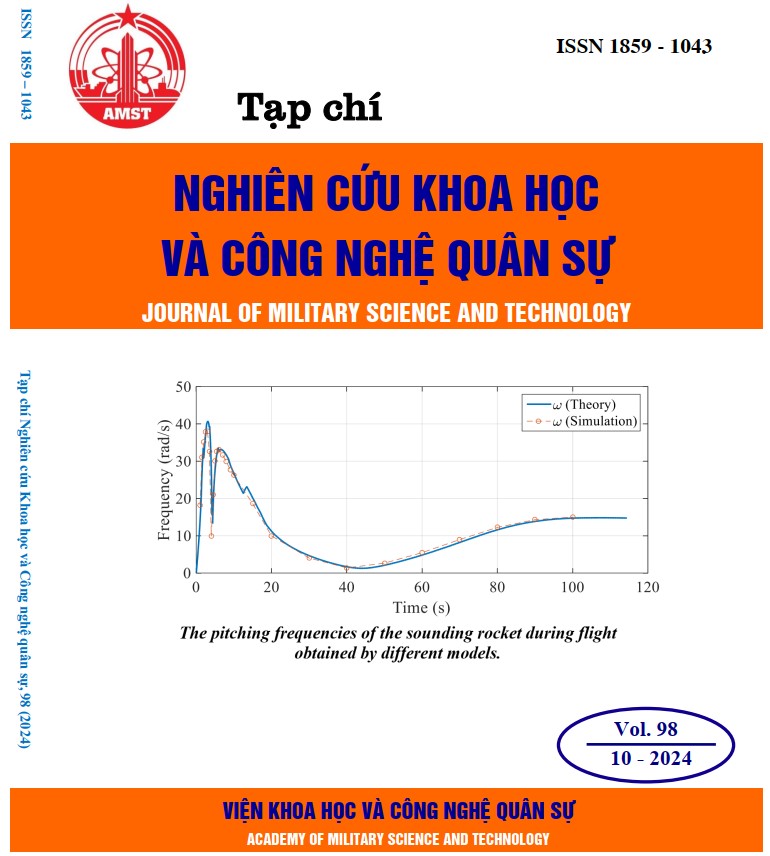Study the variation of the pitching frequency of sounding rockets
558 viewsDOI:
https://doi.org/10.54939/1859-1043.j.mst.98.2024.146-154Keywords:
Sounding rocket; Resonance; Short-period oscillations; Fourier transform.Abstract
Sounding rockets typically feature an axially symmetric design and are launched vertically to facilitate research and high-altitude atmospheric data collection. Manufacturing errors can cause axial asymmetry, leading to undesirable rocket trajectory dispersion. Sounding rockets are often designed to spin around their axis to mitigate these effects. However, axial spinning motion can resonate with short-period oscillations, creating large normal loads that may damage the rocket’s structures. This paper focuses on analyzing the variations in the pitching frequency, which may help predict the roll resonance phenomenon. In this study, the authors constructed a six-degree-of-freedom dynamic model for a sounding rocket, considering all aerodynamic problems and the variation of inertial characteristics. To determine the pitching frequency, an impulse is applied to the rocket to generate short-period oscillation. The Fourier transform is then used to analyze and obtain the frequency of the rocket while oscillating in space. The results demonstrate agreement with the theoretical model, thereby substantiating the validity of the current method. The findings of this research provide valuable recommendations for the design and manufacturing process of sounding rockets, which may help mitigate the adverse effects of motion resonance during flight.
References
[1]. R. F. Stengel, “Flight performance of a small, low-altitude rocket”, Journal of Spacecraft Rockets and Spacecrafts, 3, (6), pp. 938-939, (1966). DOI: https://doi.org/10.2514/3.28569
[2]. R. H. Burth, P. G. Cathell, D. B. Edwards, A. H. Ghalib, J. C. Gsell, H. C. Hales, H. C. Haugh, and B. R. Tibbetts, "NASA Sounding Rockets User Handbook," (2023).
[3]. G. Boersma, J. Bosgra, H. Kruisbrink, and C. Schmeitink, “Comparison of the impact dispersion of unguided and guided sounding rockets with further evaluation of a velocity controlled rocket”, 2nd Sounding Rocket Technology Conference, p. 1381, (1970). DOI: https://doi.org/10.2514/6.1970-1381
[4]. G. H. Greenwood, “Measurements of drag, base pressure and base aerodynamic heat transfer appropriate to 8.5 degrees semi-angle sharp cones in free flight at mach kneelers from 0.8 to 3.8”, Ministry of technology, Aeronautical research council Current papers, (1967).
[5]. R. G. Hart, “Flight investigation at mach numbers from 0.8 to 1.5 to determine the effects of nose bluntless on the total drag of two fin-stablized body of revolution”. Aeronautical Laboratory Langley Air Force Pae, Va., (1950).
[6]. E. Carrera, T. Cavallo, and E. Zappino, “Effect of Solid Mass Consumption on the Free-Vibration Analysis of Launchers”, Journal of Spacecraft and Rockets, 54, (3), pp. 774-781, (2017). DOI: https://doi.org/10.2514/1.A33650
[7]. D. A. Price, “Sources, mechanisms, and control of roll resonance phenomena for sounding rockets”, Journal of Spacecraft and Rockets, 4, (11), pp. 1516-1525, (1967). DOI: https://doi.org/10.2514/3.29122
[8]. F. Scheurpflug, A. Kallenbach, F. Cremaschi, “Sounding Rocket Dispersion Reduction Impact by Second Stage Pointfufouring Control”, Journal of Spacecraft and Rockets, 49, (6), pp. 1159-1162, (2012). DOI: https://doi.org/10.2514/1.A32193
[9]. P. D. J. J. o. s. s. e. Wilde, “Range safety requirements and methods for sounding rocket launches”, 5, (1), pp. 14-21, (2018). DOI: https://doi.org/10.1016/j.jsse.2018.01.002
[10]. E. G. Rolf Wubben, Krijn de Kievit, Bart Kevers, Maurits van Heijningen, Martin Christiaan Olde., “Investigation of the in-flight failure of the Stratos III Sounding Rocket”, ISASI., (2019).
[11]. J. R. B. a. G. E. Kraft, “Aerobee 150 structural and aerodynamic pitch coupling Goddard Space Flight Center”, (1966).
[12]. R. C. Nelson, “Flight stability and automatic control”, WCB/McGraw Hill New York, (1998),
[13]. N. L. Crabill, “Ascent problems of sounding rockets”, (1961).
[14]. V. D. T. Le, A. T. Nguyen, L. H. Nguyen, N. T. Dang, N. D. Tran, and J.-H. Han, “Effectiveness analysis of spin motion in reducing dispersion of sounding rocket flight due to thrust misalignment”, International Journal of Aeronautical and Space Sciences, 22, (5), pp. 1194-1208, (2021). DOI: https://doi.org/10.1007/s42405-021-00383-x
[15]. F. A. Woodward, “Analysis and design of wing-body combinations at subsonic and supersonic speeds”, Journal of Aircraft, 5, (6), (1968), pp. 528-534. DOI: https://doi.org/10.2514/3.43979
[16]. E. L. Fleeman, “Technologies for future precision strike missile systems-missile design technology”, RTO SCI Lecture Series on Technologies for Future Precision Strike Missile Systems. Published in RTO-EN-018, (2001).
[17]. Ü. Gülçat, “Fundamentals of modern unsteady aerodynamics”, Springer, (2010), DOI: https://doi.org/10.1007/978-3-642-14761-6
[18]. J. Katz and A. Plotkin, “Low-speed aerodynamics”, Cambridge university press, (2001), DOI: https://doi.org/10.1017/CBO9780511810329
[19]. J. Allen and M. Ghoreyshi, “Forced motions design for aerodynamic identification and modeling of a generic missile configuration”, Aerospace Science Technology, 77, pp. 742-754, (2018). DOI: https://doi.org/10.1016/j.ast.2018.04.014
[20]. A. D. Dupuis and W. Hathaway, “Aeroballistic range tests of the basic finner reference projectile at supersonic velocities: Defence Research Establishment Valcartier”, (1997),
[21]. A. Dupuis, “Aeroballistic range and wind tunnel tests of the Basic Finner reference projectile from subsonic to high supersonic velocities”, Defense R&D Canada TM, 136, (2002).
[22]. C. P. Hoult and Rockets, “Launcher length for sounding-rocket point-mass trajectory simulations”, Journal of Spacecraft, 13, (12), pp. 760-761, (1976). DOI: https://doi.org/10.2514/3.27949
[23]. J. R. Busse and G. E. Kraft, “Aerobee 150 structural and aerodynamic pitch coupling”, National Aeronautics and Space Administration, (1966).







